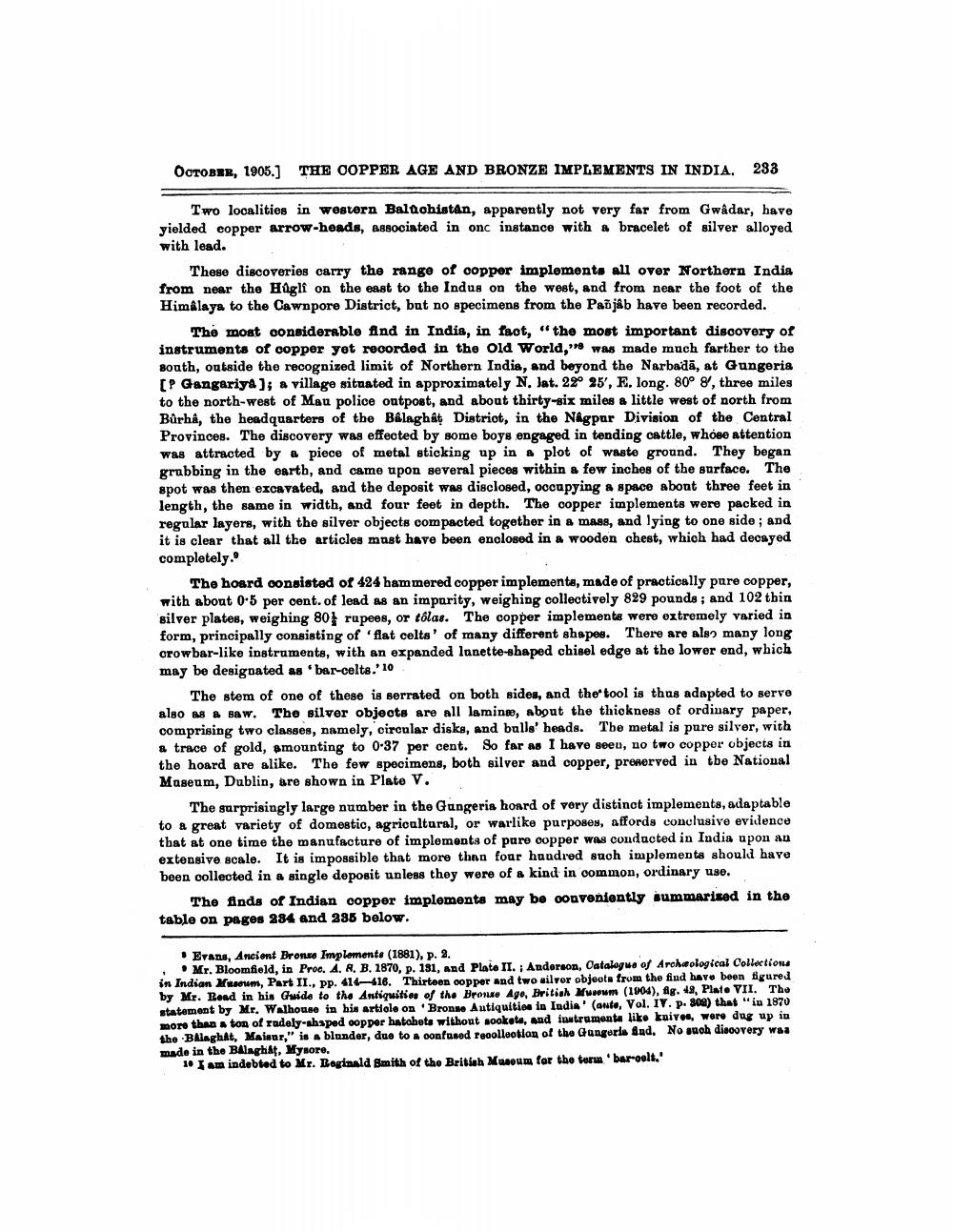________________
OCTOBAR, 1905.) THE OOPPER AGE AND BRONZE IMPLEMENTS IN INDIA. 233
Two localitios in western Balochistan, apparently not very far from Gwadar, have yielded copper arrow-heads, associated in onc instance with a bracelet of silver alloyed with lead.
These discoveries carry the range of copper implements all over Northern India from near the Haglf on the east to the Indus on the west, and from near the foot of the Himalaya to the Cawnpore District, but no specimens from the Pañjab have been recorded.
The most considerable find in India, in fact, “the most important discovery of instruments of oopper yet recorded in the old World," was made much farther to the south, outside the recognized limit of Northern India, and beyond the Narbadā, at Gungeria [P Gangariya); a village situated in approximately N. lat. 22° 25', E. long. 80° 8, three miles to the north-west of Mau police ontpost, and about thirty-six miles a little west of north from Bürha, the headquarters of the Balaghat District, in the Nagpur Division of the Central Provinces. The discovery was effected by some boys engaged in tending cattle, whose attention was attracted by a piece of metal sticking up in a plot of wasto ground. They began grubbing in the earth, and came upon several pieces within a few inches of the surface. The spot was then excavated, and the deposit was disclosed, occupying a space about three feet in length, the same in width, and four feet in depth. The copper implements were packed in regular layers, with the silver objects compacted together in a mass, and lying to one side ; and it is clear that all the articles must have been enclosed in a wooden chest, which had decayed completely.
The hoard consisted of 424 hammered copper implementa, made of practically pure copper, with about 0-5 per cent. of lead as an impurity, weighing collectively 829 pounds; and 102 tbin silver plates, weighing 80 rupees, or tolas. The copper implements were oxtremely varied in form, principally consisting of 'flat celts' of many different shapes. There are also many long crowbar-like instruments, with an expanded lanette-shaped chisel edge at the lower end, which may be designated as 'bar-celts.'10.
The stem of one of these is serrated on both sides, and the tool is thus adapted to serve also as a saw. The silver objects are all lamine, about the thickness of ordinary paper, comprising two classes, namely, circular disks, and balls' heads. The metal is pure silver, with a trace of gold, amounting to 0-37 per cent. So far as I have seeu, no two copper objects in the hoard are alike. The few specimens, both silver and copper, proverved in tbe National Museum, Dublin, are shown in Plate V.
The surprisingly large number in the Gangeris hoard of very distinct implements, adaptable to a great variety of domestic, agricultural, or warlike purposes, affords conclusive evidence that at one time the manufacture of implements of pare oopper was conducted in India upon au extensive scale. It is impossible that more than four hundred such implements should have been collected in a single deposit unless they were of a kind in common, ordinary use.
The finds of Indian copper implements may be conveniently summarised in the tablo on pages 284 and 296 below.
Evans, Ancient Bronco Implemente (1881), p. 2. . .MrBloomfield, in Proo. 4. R. B. 1870, p. 131, and Plate II. ; Anderson, Catalogue of Archeological Collections in Indian Museum, Part II., PP. 414 416. Thirteen oopper and two silvor objeots from the fiud have been figured by Mr. Rond in his Guide to the Antiquities of the Brorue Age, British Museum (1904), Ag. 19, Plato VII. The statement by Mr. Walhouse in his article on Bronze Autiquities in India' (ante, Vol. IV. p. 308) that "iu 1870 more than ton of rudely-shaped ooppor hatohete without sookata, and lustrumentu liko kuives, were dug up in the Balaghat, Maimur," is blunder, due to confused reoollootion of the Congoria Sud. No such discovery was made in the Balaghat, Mysore.
10 I am indebted to Mr. Raginald Bmith of the British Museum for the term 'bar oolt.




